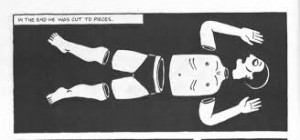Upon completion of Persepolis, I have begun to wonder what is actually captivating about this story. Is it Satrapi’s literary and graphic skills that woo us- her ability “to intertwine unspeakability, invisibility, and inaudibility”- in a rather simplistic prose and illustration? Is it the historical significance of the story (let’s be honest, an Islamic revolution is no joke)? Is it the quintessential coming of age story, such as Catcher in The Rye by J.D. Salinger, which us Westerners know and love? Or is it the author Marjane Satrapi’s departure from Iran, which eventually leads her to settle in the Western World? After a significant amount of time letting all-of-the-above brew, I believe it is a mixture of the last two.
In its essence, Persepolis is about a quick-witted young girl finding out about life while being beset by the calamities of Arab Spring. Hillary Chute summarizes it best:
“Persepolis narrates the tribes and tribulations of precocious Marji and her upper-class leftist parents: their protests against the Shah, and later against the Islamic regime; Marji’s growing class consciousness; the torture and killing of family and friends; the havoc wreaked by the Iran-Iraq war; and Marji’s fierce and dangerous outspokenness, which eventually leads her fearful parents to send her out of the country at the age fourteen.”
The historical context- or setting- is secondary to Marji’s growth. Marji’s childlike naivety- her ability to express or imagine the chaos and horror that is all around her, not for what it is, but for how she innocently perceives it- is what captivates us. For instance, when Marji hears about a man being cut into pieces, her subsequent illustration of this is not of a man with lacerations at all the major joints with his bones protruding, covered with bloodied excess flesh, it is of a stick figure whose limbs, along with his torso and head, are detached from each other (image below). She lacks the maturity that comes with age and consequently cannot depict occurrences as such, for what they really are.

At first glance Catcher and the Rye and Persepolis can be seen as apples and oranges. However, the characterization of Holden Caulfield in Catcher in The Rye is similar to Marji’s in Persepolis. Holden Caulfield embarks on an odyssey of finding himself that is akin to Marji (i.e. Holden is finding himself through the awkwardness and alienation of being a teenager and Marji amidst a time of war). While both characters possess an immense amount of potential, they both unfortunately have to combat negative aspects of life, as well.
As I previously mentioned, Persepolis ends with Marji leaving Iran to move to Europe. Satrapi spends the rest of her life in Europe, and became just as proficient with Western languages as she is with her mother tongue. In short, she has assimilated (some could even say succumbed) to the Western World. Her story is solely intended for a Western audience. Satrapi enlightens the world on her truth by adroitly telling her story through the lens of a young girl which in turn, limits how truthful she can be; as if the whole truth would be too much, too real, too hard to handle if it was told in a more accurate manner. Satrapi does not want to create western guilt. She does not want the West to dwell on the fact that yet again, western imposition has led to a coup d’état. She avoids that by being as fictitious as one could be in the genre of non-fiction. Which begs the question, is this story in fact a piece of non-fiction? Ostensibly, Persepolis is an auto-graphic-narrative, yet in actuality it’s merely just a piece of historical fiction.
Although it’s Marjane Satrapi’s narrative, her story has been fabricated to meet Western appeal. Nonetheless Persepolis is still a great story and piece of literature. Marji’s fine balance of innocence and naivety enables the story to be relatable to almost every adolescent. Satrapi’s creative portrayal of her story makes it both insightful and engaging, yet not overbearing.
This is an interesting take on Persepolis, initially I never though of the book as being a text that was altered to better suit western individuals; I actually considered it to be a traditional display of her experience. Reading your blog post made me think back on the graphic narrative in turn I picked up on some areas of the narrative that do seem to be altered to appeal to the typical western reader. I appreciate your alternative critique of the book, it has offered a new way for me to approach it.
This was a really compelling post Bernard, I found it pretty intriguing.
I like how you described Persepolis as being targeted towards a Western audience. I can see where you coming from with that, but I also believe she intended for the people back in Iran. For me it seems as though she’s trying to reach anyone who’ll listen, and she sure did succeed in that aspect. I really liked your comparison with Catcher in the Rye, it’s something I had never thought of before. You could also compare it with To kill a mockingbird since it’s a also a coming-of age story.
Daniel Vera